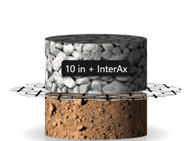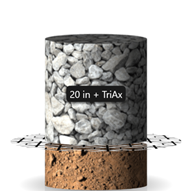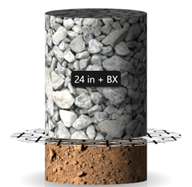Biaxial geogrid was invented by Tensar in the late 1970s. Biaxial geogrids have square or rectangular openings, called apertures. Different types of biaxial geogrids exist on the market, but for roadbed applications, testing has consistently shown that integral geogrids made by a process known as punched and drawn perform best. In 2007, Tensar introduced multiaxial geogrids, known as TriAx. These geogrids have triangular apertures and ribs with a higher aspect ratio than biaxial geogrids. This geometry provides better interlock with the surrounding aggregate than biaxial geogrids, resulting in improved performance in stabilisation applications. In 2021, Tensar introduced InterAx geogrids. InterAx builds on the decades of knowledge and testing at Tensar to deliver a higher level of performance. Through thousands of hours and millions of dollars of research and development, we combined advanced materials science, a revolutionary new geometry, extensive performance validation testing, and an entirely new design approach to deliver better solutions that are more economical, longer lasting, more resilient, and more sustainable.
| Characteristic |
InterAx |
TriAx |
BX |
| Development |
InterAx geogrids were introduced in 2021, representing a significant leap forward in geogrid design and materials |
TriAx geogrids were introduced in 2007, which marked an advancement in geosynthetic technology |
BX geogrids have been around since the late 1970s |
| Generation |
Third |
Second |
First |
| Aperture Geometry |
Triangular, Hexagonal, Trapezoidal |
Triangular |
Square |
| Material Structure |
Coextruded - Three Layers |
Monolithic - Single Layer |
Monolithic - Single Layer |
| Stabilisation Direction |
Longitudinal, transverse, and diagonal |
Llongitudinal, transverse, and diagonal |
Longitudinal and transverse |
| Performance |
Best load distribution and interlocking capabilities with various types of fill materials |
Adequate load distribution and interlocking capabilities |
Limited load distribution |
| Performance Differential |
|
|
|





